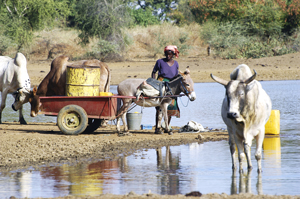
Clark Wolf, Iowa State University Director of Bioethics
The Need for Innovation
Farmers throughout the world are facing new challenges, and this is especially true for farmers in developing countries. In Bangladesh, rising seas inundate precarious agricultural lands. In sub-Saharan Africa, people face unprecedented drought. In China and India, farmers face changes resulting from shrinking glaciers that no longer stabilize the flow of river water and may not be relied on to provide water for other crucial services. While skeptics resist the notion that biotechnology might help to address these problems, efforts are already under way. Flood-and drought-resistant varieties of rice and other staple crops are under development. Some of these new varieties have been field tested, and promise to be valuable for producers who face changing environmental circumstances.

The question remains whether these new varieties will be available to those who need them most. Poor farmers in Bangladesh and Africa are not likely to have resources to purchase seed to grow new varieties. Even if other resistance to new crop varieties is overcome, patent and other intellectual property (IP) protections may prove to be a decisive barrier, barring access for poor farmers who must produce on marginal land. It is paradoxical that intellectual property rules simultaneously provide an incentive for the creation of new technologies, while sometimes barring access to innovations they protect.
International IP Protections and “ordre public”
Critics of international intellectual property law point out that there are disadvantages when IP protections are strengthened and systematized through reciprocal international arrangements and treaties. When IP rules are strong, the benefits of new technology will be less widely available. Because of this, some nations have tried to restrict these rules as a way to insure that people will have access. For example, by limiting IP protections for drugs, India has made medical treatment more affordable for poor people; by refusing to recognize some American patents, Canada has increased access to some life-saving medical tests. Some nations restrict intellectual property protections because they conflict with customs or values. For example, provisions for intellectual property protection in the World Trade Organization charter permit nations to deny patent protection to living organisms if people have moral objections to such patents. But the persistent and reasonable concern is that pending international treaties like the Trans Pacific Partnership and the Transatlantic Trade and Investment Partnership might make it impossible for nations to restrict intellectual property protections even where such restrictions would serve the public interest.
Patent laws are not in place to promote the private interests of patent holders, they are justified as a way to promote broad public values. When IP rules don’t serve the public interest, they work against the values that justified them in the first place. Patents and other IP rules are put in place to provide an incentive for valuable innovations that promote the public good. By securing a temporary monopoly for inventors, patents provide researchers with an opportunity to recover the cost of developing new technologies, as well as creating profit. In return, the public gets new innovative technologies that would not otherwise be available. The amount inventors can expect to recover depends on the economic value of their innovation, providing a motive to develop innovations whose value will be recognized by other people.

However, it doesn’t always work that way: Intellectual property rules are sometimes misused and abused. Sometimes inventors are awarded patents on products that are already in use, so the result is not access to new technology, but rather barriers to the use of old technologies. Another weakness of patents and intellectual property rules is that they do not motivate innovation in some areas where innovation is sorely needed. Where those who would benefit from innovation are poor, inventors may not even be able to make back their investment in research and development. Why do we live in a world where billions of dollars have been invested to address non-lethal conditions like baldness and erectile dysfunction, and there is comparatively little research done on diseases like cholera and malaria, which kill huge numbers of people every year? It is because the people who die of cholera and malaria are poor. In these areas of orphaned drug research, innovation would be socially valuable but cannot be supported by market demand. There are similar areas of orphaned crop research_. _Why is there more research on corn, beans, and rice than on manioc, yams, and plantains? It is because the latter-listed food crops are consumed disproportionately by poor people. You can’t get rich by creating products for the poor.
There have been efforts to develop alternative incentives to spur innovation in these key areas that promise important public benefits, but they are unlikely to provide much financial reward because those who benefit are poor. One proposal involves an alternative to standard intellectual property rules. Instead of rewarding people for the market value of their inventions, a fund might be created that rewards inventors based on the number of lives saved, or by how much peoples’ lives are improved by their invention. The Health Impact Fund, initiated by the German philosopher Thomas Pogge, seeks to do just this for orphaned drug research. It is easy to imagine a correlate program that would focus on agriculture and orphaned crops though it might be more difficult to estimate the human impact of agricultural research than for medical research.
Where innovation is underway, how can we insure that new products will be available to those who need them? Perhaps it is possible to harness provisions in existing and forthcoming trade agreements to promote access to needed technologies. International intellectual property agreements already do this to some extent. The recently-leaked IP Chapter from the forthcoming Trans-Pacific Partnership [TPP], for example, includes a clause specifying that “Each party may exclude from patentability inventions, the prevention of which is necessary to protect ordre public or morality, including to protect human, animal or plant life or health or to avoid serious prejudice to nature of the environment, provided that such exclusion is not made merely because the exploitation is prohibited by their law.” The TPP also includes clauses that allow member nations to exclude from patentability “diagnostic, therapeutic, and surgical methods for the treatment of humans and animals” and (with some restrictions) “plants and animals other than microorganisms, and essentially biological processes for the production of plants or animals. However, the Parties shall provide for the protection of plant varieties either by patents or by an effective sui generis system or by any combination thereof.” ‘Sui generis’ means ‘unique,’ or ‘self-generated,’ or, more colloquially, ‘home grown.’ In effect, this provision allows nations to develop their own “home grown” variety of intellectual property protection, even if it is different from the international norm.
A Modest Proposal
These exemptions to patent law for the protection of “ordre public or morality” are included verbatim in many different places in international patent law and in the European Patent Code. Patent lawyers have spent ink and agony trying to specify what these terms mean and which restrictions on patent law should properly be permitted under these restrictions. Which home grown alternatives to standard patents would be appropriate under these provisions? It is quite safe to say, at this point, that the interpretation of these terms is somewhat fluid, and they are included expressly to allow nations to restrict intellectual property protections when doing so would serve the public good.
My proposal here is that these provisions could be used to insure that poor farmers are not inappropriately denied access to agricultural technologies that would serve their needs. What if Indonesia or Bangladesh, for example, restricted patent protection for agricultural varieties, specifying that intellectual property rules shall not cover the first $10,000 US of income earned. Because $10,000 is more than most poor farmers earn in a year, such a provision would rule out enforcement of intellectual property restrictions for less-well-off producers– the people who might benefit most from the use of these new crops.
Objections and Problems?
Such a proposal would not be unheard of. The creators of golden rice, a beta carotene-enriched rice that helps prevent blindness, developed a similar plan to provide golden rice for free to low-income farmers. Since golden rice was created expressly to benefit poor farmers, researchers responsible for its creation considered different ways to insure that their product would be widely available.
This proposal to provide patented technologies for free to people who need them will not please everyone. One concern is that it might undermine the value of intellectual property protections, diminishing the incentive for innovation. But it is already clear that inventors don’t make their profit from the poor. Since poor farmers are not a lucrative market in any case, allowing them free use of patented crop varieties will likely have a negligible effect on the value of the patents involved.
Like other regulations, the proposed restriction might be vulnerable to misuse or manipulation. Might large-scale producers use it to avoid paying licensure fees, by hiring many small farmers, or by dividing their fields into smaller plots? Similar problems arise in the case of many new regulatory regimes, and they have been shown to be solvable.
If new agricultural technologies are to live up to their promise, they must be available for use by people with few resources. It will not be costly to patent holders if products are provided without licensure fees to poor farmers who need them most. If intellectual property rights are restricted in this way, it will make it more likely that research on new agricultural varieties will live up to the ideals of those who create them.